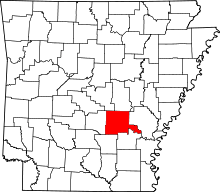Sulphur Springs, Jefferson County, Arkansas
| Sulphur Springs, Arkansas | |
|---|---|
| Census-designated place | |
 Sulphur Springs, Arkansas | |
| Coordinates: 34°10′50″N 92°07′25″W / 34.18056°N 92.12361°WCoordinates: 34°10′50″N 92°07′25″W / 34.18056°N 92.12361°W | |
| Country | United States |
| State | Arkansas |
| County | Jefferson |
| Area[1] | |
| • Total | 5.579 sq mi (14.45 km2) |
| • Land | 5.579 sq mi (14.45 km2) |
| • Water | 0 sq mi (0 km2) |
| Elevation | 292 ft (89 m) |
| Population (2010)[2] | |
| • Total | 1,101 |
| • Density | 200/sq mi (76/km2) |
| Time zone | Central (CST) (UTC-6) |
| • Summer (DST) | CDT (UTC-5) |
| Area code(s) | 870 |
| GNIS feature ID | 78494[3] |
Sulphur Springs is a census-designated place in Jefferson County, Arkansas, United States. Its population was 1,101 as of the 2010 census.[2]
Until 1984, the area west of Pine Bluff through what is now Jefferson and Grant Counties was a mostly unpopulated wilderness. In that year, the Mississippi and Arkansas Rivers flooded the Delta area east of Pine Bluff, covering all of southeast Arkansas except for some of the absolute high points. This western area was very hilly, and had mostly small streams which did not flood. Shortly after the flood, the George Brummitt family moved from Desha County to what became White Sulphur Springs. He bought this 40 acres on what is now the site of White Sulphur Springs Camp from the Federal Government with a War of 1812 land bounty and patented an additional 360 acres around the circumference of the spring property.
Many others saw the wisdom of settling on higher ground, including Brushrod Lee, who settled about a mile west near several springs and built a plantation known as Lee Springs. Lee was a doctor and with the establishment of his large house and medical practice, the community became a destination for folks from all over the state to come and drink and bathe in the waters from the two sets of springs. Pine Bluff residents and others made summer homes in the area.
In 1855 the burgeoning community applied for a post office for the town under the name of Sulphur Springs, but since there already was a town by that name in the northwestern part of the state, they chose the name White Sulphur Springs instead. During the Civil War, White Sulphur Springs became a staging and training area for troops in the Pine Bluff unit. The Confederate Hospital was moved to White Sulphur Springs from Pine Bluff in 1862, and many died and were buried in the White Sulphur Springs Confederate Cemetery. In September 1863 the Union Army burned the town, leaving nothing. Most area citizens abandoned or sold their land and left the vicinity. According to census records, almost none of those who lived at White Sulphur Springs in 1860 were here in 1870.
In 1870 a Methodist minister named Reverend Benjamin Watson moved to the area, became a Presbyterian, and founded a church and school which was later known as Watson Chapel.
It was 25 years after the war before the springs became the site of a real town again with the building of a hotel by two men, one black and one white. Unfortunately they were burned out twice, possibly by prohibitionists or racists. Eventually they successfully rebuilt but the town never recovered its former glory.
After the Civil War, local residents continued to bury their dead in Camp White Sulphur Springs Confederate Cemetery, with only a few of the grave sites being marked.[4]
References
- ↑ "US Gazetteer files: 2010, 2000, and 1990". United States Census Bureau. 2011-02-12. Retrieved 2011-04-23.
- 1 2 "American FactFinder". U.S. Census Bureau. Retrieved 6 May 2011.
- ↑ U.S. Geological Survey Geographic Names Information System: Sulphur Springs, Jefferson County, Arkansas
- ↑ "CAMP WHITE SULPHUR SPRINGS CONFEDERATE CEMETERY, SULPHUR SPRINGS, JEFFERSON COUNTY". Arkansas Historic Preservation Program. Retrieved 19 April 2014.
